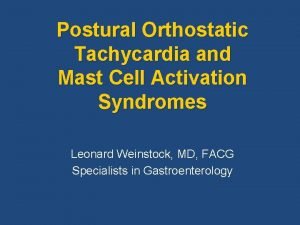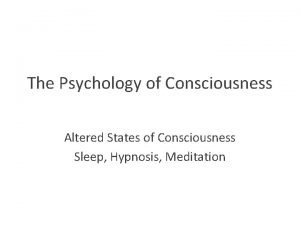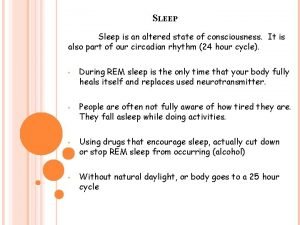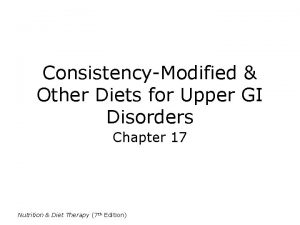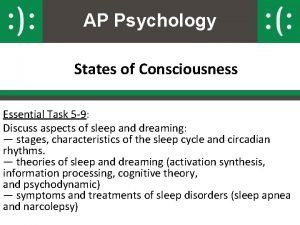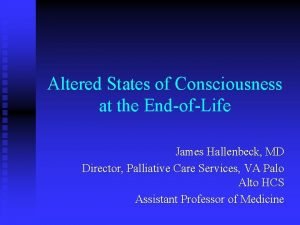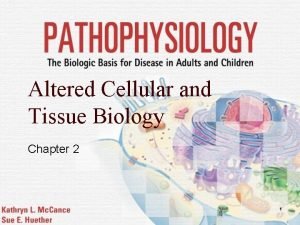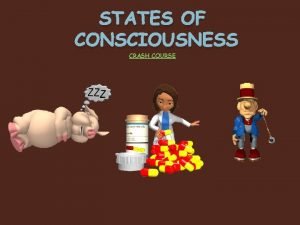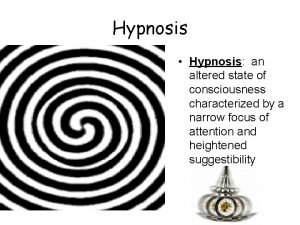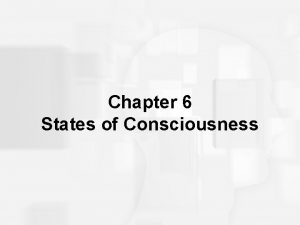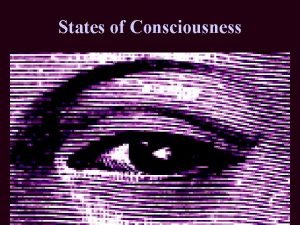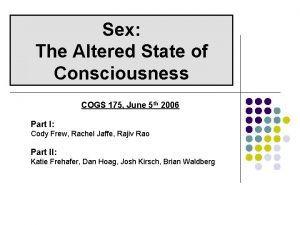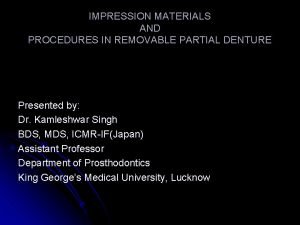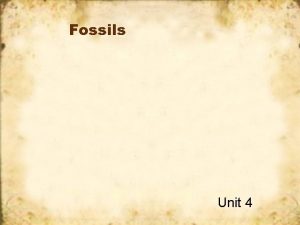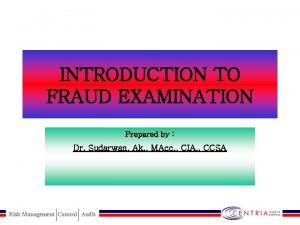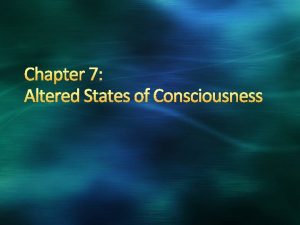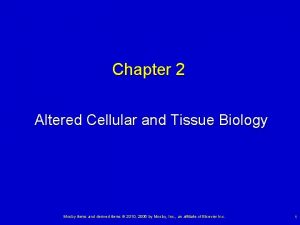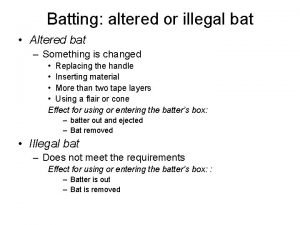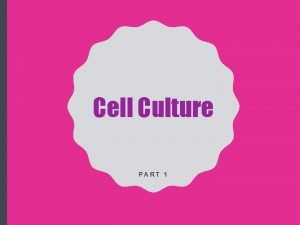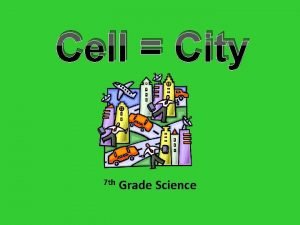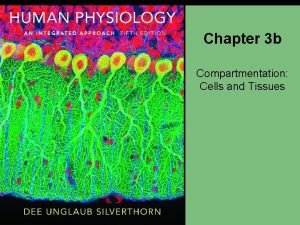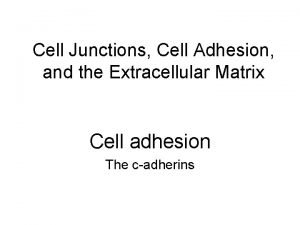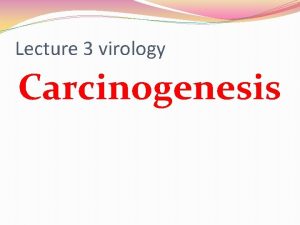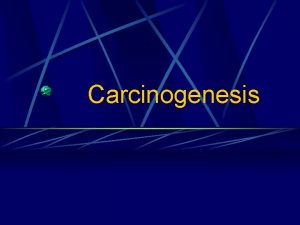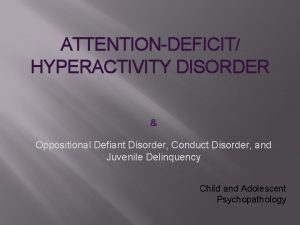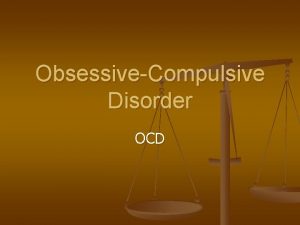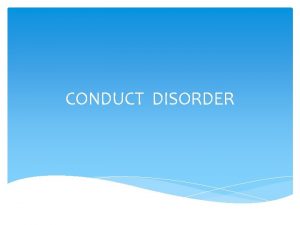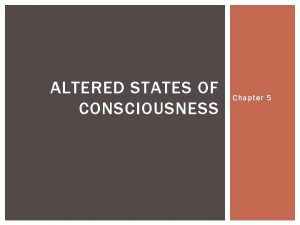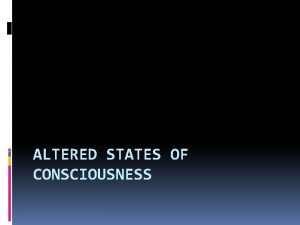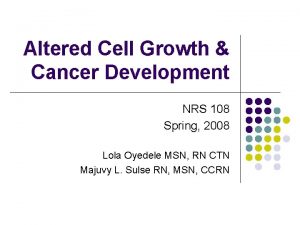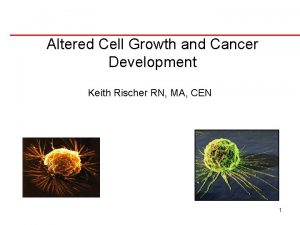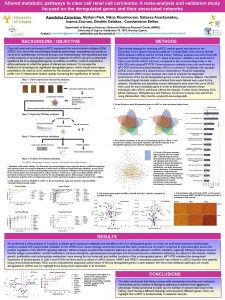Carcinogenesis Characteristics of Cancer Disorder of altered cell





















































- Slides: 53

Carcinogenesis

Characteristics of Cancer Disorder of altered cell differentiation and growth l Results in neoplasia (“new growth”) Growth is uncoordinated and relatively autonomous l Lacks normal regulatory controls over cell growth and division l Tends to increase in size and grow after stimulus ceases or needs of organism are met

Determination and Differentiation

The Cell Cycle Definition: The interval between each cell division Genetic information is duplicated l Duplicated chromosomes are appropriately aligned for distribution between two genetically identical daughter cells Checkpoints in cycle provide opportunities for monitoring the accuracy of deoxyribonucleic acid (DNA) replication l Edited and repaired defects ensure full complement of genetic information to each daughter cell

Control of Cell Cycle

Control of Cell Cycle The cell cycle is controlled by many proteins from inside & outside the cell. Intracellular cyclins and cyclin dependent kinases (CDKs) control the checkpoints. Extracellular proteins from other cells called Growth Factors signal the target cell to divide. Binding of growth factors to membrane receptor proteins of the target cell triggers a molecular signaling pathway - a series of proteins which allows the cell to pass the checkpoints of the cell cycle.

Cell Cycle is controlled by genes.

Tumor Suppressor Proteins Inhibit Cell Division & Prevent Cancer Tumor suppressor proteins are proteins that bind to checkpoint proteins to stop the cell cycle & prevent cell division. An important function of tumor suppressor proteins is to stop the division of mutated cells until mistakes in DNA are repaired by enzymes. TS proteins keep most mutations from being passed on to daughter cells & developing into cancer. If the genes for TS proteins mutate or are deleted cancers may result. Two important TS proteins are the p 53 protein & the RB protein.

Cell Proliferation Definition l The process by which cells divide and reproduce Regulation l Regulated in normal tissue, so the number of cells actively dividing equal the number of cells dying or being shed

Two Major Categories of Cells Existing in Humans Gametes (ovum and sperm) l l Haploid (containing one set of chromosomes from one parent) Designed for sexual fusion forming a diploid cell (containing both sets of chromosomes) Somatic cell l The diploid cell that forms the rest of the body

Categories of Cell Types of the Body Well-differentiated neurons and cells of skeletal and cardiac muscle unable to divide and reproduce Parent or progenitor cells that continue to divide and reproduce l Blood cells, skin cells, liver cells Undifferentiated stem cells that can be triggered to enter cell cycle and produce large numbers of progenitor cells when needed

Types of Tumors Adenoma: benign tumor of glandular epithelial tissue Adenocarcinoma: malignant tumor of glandular epithelial tissue Carcinoma: malignant tumor of epithelial tissue Osteoma: benign tumor of bone tissue Sarcoma: malignant tumors of mesenchymal origin Papillomas: benign microscopic or macroscopic fingerlike projections growing on a surface

Factors differentiating Benign and Malignant Neoplasms Cell characteristics Manner of growth Rate of growth Potential for metastasizing or spreading Ability to produce generalized effects Tendency to cause tissue destruction Capacity to cause death

Characteristics of Benign Neoplasms A slow, progressive rate of growth that may come to a standstill or regress An expansive manner of growth Inability to metastasize to distant sites Composed of well-differentiated cells that resemble the cells of the tissue of origin

Characteristics of Malignant Neoplasms Tend to grow rapidly and spread widely Have the potential to kill regardless of their original location Tend to compress blood vessels and outgrow their blood supply, causing ischemia and tissue necrosis Rob normal tissues of essential nutrients Liberate enzymes and toxins that destroy tumor tissue and normal tissue

Methods by which Cancer Spreads Direct invasion and extension Seeding of cancer cells in body cavities Metastatic spread through the blood or lymph pathways

Factors Affecting Tumor Growth The number of cells that are actively dividing or moving through the cell cycle The duration of the cell cycle The number of cells that are being lost compared with the number of new cells being produced

Carcinogenesis Hypotheses of the Origin of Neoplasia 1. Oncogenes and Tumor Suppresor Genes 2. Viral Oncogene Hypothesis 3. Epigenetic Hypothesis 4. Failure of Immune Surveillance

1. Oncogenes and Tumor Suppresor Genes that Control Cell Growth and Replication Genes control cell division by cytokines. Three classes of regulatory genes. 1. 2. 3. Promotors – Proto-oncogenes Inhibitors – Cancer-suppressor genes – p 53 DNA stability genes.

Non-lethal Genetic damage lies at the center of carcinogenesis. Loss/damage to suppressor genes, Duplication of promotor genes Loss/damage of DNA stability genes.

Alterations of Specific Cellular Functions in Cancer Tumor Suppressor Genes Oncogenes Inactivation Activation Differentiation Apoptosis/Proliferation CANCER

Proto-oncogenes Oncogenes: l Viral proteins which interact with the cellular controll mechanisms to overcome the strict regulation of proliferation (v-ras, v-myc, v-abl, . . . ) Proto-Oncogenes: l Cellular proteins which correspond to the viral Oncogenes but which are strictly regulated. Mutations in this genes could transform a cell into a tumor cell (c -ras, c-myc, c-abl, . . . ).

Proto-oncogenes TYPES OF ONCOGENES 1. 2. 3. 4. 5. Growth factors receptors Intracellular signaling transduction factors Proteins with GTPase activity Cytoplasmic serine threonine kinases DNA-binding nuclear proteins Cell cycle factors

Relationship between gene products of proto oncogene Growth factors eg IGF Growth factor receptors Eg erb-2, ret Signal transducing factors Eg cytoplasmic kinases cell cycle proteins eg cyclin D DNA binding proteins concerned with transcription

Proto-oncogenes FUNCTION OF ONCOGENES Cancers have characteristics that indicate, at cellular level, loss of the normal function of oncogene products consistent with a role in the control of cellular proliferation and differentiation in the process known as signal transduction. It is a complex multistep pathway from the cell membrane, through the cytoplasm to the nucleus. Proto oncogenes have been highly conserved during evolution, and the protein products they encode are likely to have essential biological functions.

Oncogenes Are Mutated Proto-oncogenes A cell can acquire a cancer causing oncogene from l A virus l A mutation in a proto-oncogene Oncogenes still code for the proteins needed for cell division but they cause cancer by producing l Increased In growth factor receptors l Increased in signal transduction l Increase in activation of transcription

Cancer causing Mutations Proto-oncogenes form oncogenes by • being misplaced (e. g. by translocation) to a site where the gene is continually expressed resulting in overproduction of a protein that stimulates cell division (e. g. in CML*) • By mutating to a form that is over expressed. Mutations in Tumor Suppressor genes cause cancer by inactivating the genes.

Tumor-suppressor genes BIOLOGICAL FUNCTIONS OF TUMOR SUPPRESSOR GENES 1. Growth Inhibitors (e. g. , TGF-β; glucocortocoids) 2. Growth Inhibitor Receptors 3. Signal Transduction Protein Inhibitors 4. Transcription Factors of Growth Inhibitors

Tumor-suppressor genes Geneproducts which are normaly responsible for negative controll of transcription and proliferation Examples: l p. Rb inhibits transcription factors of the E 2 F-family, which are needed to get into the S-Phase of the cell cycle (Restriction Point) l p 53 induces transcription of the CDK-inhibitor (CDI) p 21 which causes a cell cycle arrest (one function) l p 53 is found upregulated in cells with a high level of DNA damage


Tumor-suppressor genes RETINOBLASTOMA • • Retinoblastoma (Rb) is a relatively rare, highly malignant childhood cancer of the developing retinal cells of the eye that usually occurs before the age of 5 years. Rb can occur either sporadically (non-hereditary form, ussually involve only one eye), or be familial (hereditary form, more commonly bilateral), which is inherited in an AD manner, and also tend to present at an earlier age.

Retinoblastoma

The p 53 Tumor Suppressor Protein The p 53 tumor suppressor protein is activated when DNA is damaged. The p 53 gene is called the “guardian angel of the genome” P 53 activates genes for proteins that l Prevent cell entering S phase l Repair DNA l Cause apoptosis (if DNA is irreparable)

DNA Stability Genes Monitor and maintain the integrity of the DNA. Loss of function promotes mutations Detection of DNA lesions decreased l Repair of damage decreased or improper l Decreased apoptosis l

Routes to Genetic Instability based on Defective DNA Repair

Carcinogenesis Hypotheses of the Origin of Neoplasia 2 – Viral Oncogene Hypothesis l RNA Retrovirus – produces DNA provirus containing viral oncogene (v-onc) is introduced, or l DNA provirus without v-onc is inserted adjacent to c-onc in host cell DNA l RNA viruses is thought to have acquired v-onc sequence by recombinant mechanism from animal cells l l DNA virus Do not contain viral oncogenes l Act by blocking suppressor gene products l Examples – HPV, EBV, HBV l

Carcinogenesis Hypotheses of the Origin of Neoplasia 3 – Epigenetic Hypothesis l Changes in the regulation of gene expression rather than in the genetic apparatus l Pattern of gene expressions responsible for tissue differentiation (ie. epigenetic mechanism) are thought to be heritable

Carcinogenesis Hypotheses of the Origin of Neoplasia 4 – Failure of Immune Surveillance l Concepts l Neoplastic changes frequently occur in cells l Altered DNA result in production of neoantigens & tumor-associated antigens l Immune response (cytotoxic) to neoantigens as foreign antigens l Neoplastic cells escaping recognition and destruction become clinical cancers

Causes of Neoplasia Environmental causes: (Carcinogens) ØChemicals ØViruses ØRadiation Hereditary causes- Genetic defects. Combination – common. Obscure defects

Carcinogenesis:

Chemical Carcinogenesis: Initiation l DNA damage eg. Benzpyrene Promotion l Histologic change – eg. Turpentine (co-carcinogens) Malignant transformation: l Visible tumor formation – further DNA damage.

Chemical Carcinogenesis: Direct Acting Carcinogens: l Alkylating Agents: Cyclophosphamide Procarcinogenes (needs activation) Polycyclic hydrocarbons – Benzpyrene l Aromatic amines, dyes - Benzidine l Natural products: Aflatoxin l Others: Vinyl chloride, turpentine etc. l

Viral Oncogenesis: Insertion of viral nucleic acids mutation Alterations in Oncogenes, cancer suppressor genes and genes regulating DNA repair resulting in up-regulation of cell division Carcinogenesis. Nobel Laureates – Varmus and Bishop v-fes, v-sis proto-oncogenes. l v-sis PDGF Brain tumours. l

Viral Oncogenesis: Human Papilloma Virus l Cervical neoplasia – warts, papilloma, ca cx Epstein-Barr virus – l Burkitts Lymphoma, Nasopharyngeal ca. Hepatitis B & C virus l Hepatocellular carcinoma.

Radiation Carcinogenesis: Ionizing radiation dysjunction random fusion mutation. Neoplasia Mutations X Ray workers – Leukemia Radio-isotopes – Thyroid carcinoma Atomic explosion – Skin cancer, Leukemia

Clinical Manifestations of Cancer Tissue Integrity l Compressed and eroded blood vessels, ulceration and necrosis, frank bleeding, and hemorrhage Cancer Cachexia l Weight loss and wasting of body fat and muscle tissue; profound weakness, anorexia, and anemia Paraneoplastic Syndromes l Manifestations in sites not directly affected by the disease

Molecular Basis of Neoplasia: y t i d e r He Proto-oncogene n o i t a i d a R l a c i m e h C c n O Vr e h Ot Oncogene

Multiple Genetic Changes Cause Cancer Multiple Hits and Multiple Factors l Knudson proposed that carcinogenesis requires 2 hits l 1 st event – initiation l l 2 nd event – promotion l l Agent = promoter Multiple hits occur – 5 or more l l Carcinogen = initiator Each hit produces a change in the genome which is transmitted to its progeny (ie. clone) Lag period l l Time between exposure (first hit) and development of clinically apparent cancer Altered cell shows no abnormality during lag period

Multiple Genetic Changes Cause Cancer



Multi-step Theory Initiation Promotion Progression

Overview of Carcinogenesis
 Somatic symptom disorder vs factitious disorder
Somatic symptom disorder vs factitious disorder Amalizumab
Amalizumab Altered state of consciousness psychology
Altered state of consciousness psychology An altered state of consciousness
An altered state of consciousness Modified diet
Modified diet Mechanically altered diet
Mechanically altered diet Altered cognition in older adults is commonly attributed to
Altered cognition in older adults is commonly attributed to Ap psychology states of consciousness
Ap psychology states of consciousness Altered state of consciousness psychology
Altered state of consciousness psychology Altered state of consciousness psychology
Altered state of consciousness psychology Mosby items and derived items
Mosby items and derived items Altered cast
Altered cast Crash course altered states
Crash course altered states Hypnosis is an altered state of consciousness
Hypnosis is an altered state of consciousness Can fingerprints be altered or disguised
Can fingerprints be altered or disguised Warm vs cool colors
Warm vs cool colors What is fossil
What is fossil Lesson quiz 7-1 altered states of consciousness
Lesson quiz 7-1 altered states of consciousness Altered state of conciousness
Altered state of conciousness Sex altered state of consciousness
Sex altered state of consciousness Fluid wax technique
Fluid wax technique Altered fossil
Altered fossil Support for distal extension denture base
Support for distal extension denture base Altered skin integrity
Altered skin integrity Altered states game
Altered states game Altered check
Altered check Consciousness def
Consciousness def Chapter 7 altered states of consciousness
Chapter 7 altered states of consciousness Altered cellular and tissue biology
Altered cellular and tissue biology Altered bat
Altered bat What is an altered book
What is an altered book Cell city worksheet
Cell city worksheet Denuding tower
Denuding tower Prokaryotic cell vs eukaryotic cell
Prokaryotic cell vs eukaryotic cell Prokaryotic and eukaryotic cells
Prokaryotic and eukaryotic cells Plant vs animal cells
Plant vs animal cells Ecell vs log cu2+
Ecell vs log cu2+ Dry cell vs wet cell
Dry cell vs wet cell Comparing plant and animal cells venn diagram
Comparing plant and animal cells venn diagram Cell wall function
Cell wall function Plant cell structure
Plant cell structure Venn diagram plant cell and animal cell
Venn diagram plant cell and animal cell Cell wall vs cell membrane
Cell wall vs cell membrane 10 cm dish surface area
10 cm dish surface area Cell line vs cell strain
Cell line vs cell strain Cell city project
Cell city project Primary cell and secondary cell
Primary cell and secondary cell Difference between bacteria and plant cell
Difference between bacteria and plant cell Cell-cell junction
Cell-cell junction Cell-cell junction
Cell-cell junction What cell organelle is like lysol spray cleaning the cell
What cell organelle is like lysol spray cleaning the cell Events of the cell cycle
Events of the cell cycle Life
Life Eukaryotic cell animal cell
Eukaryotic cell animal cell

